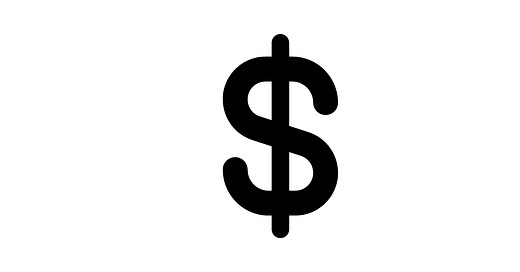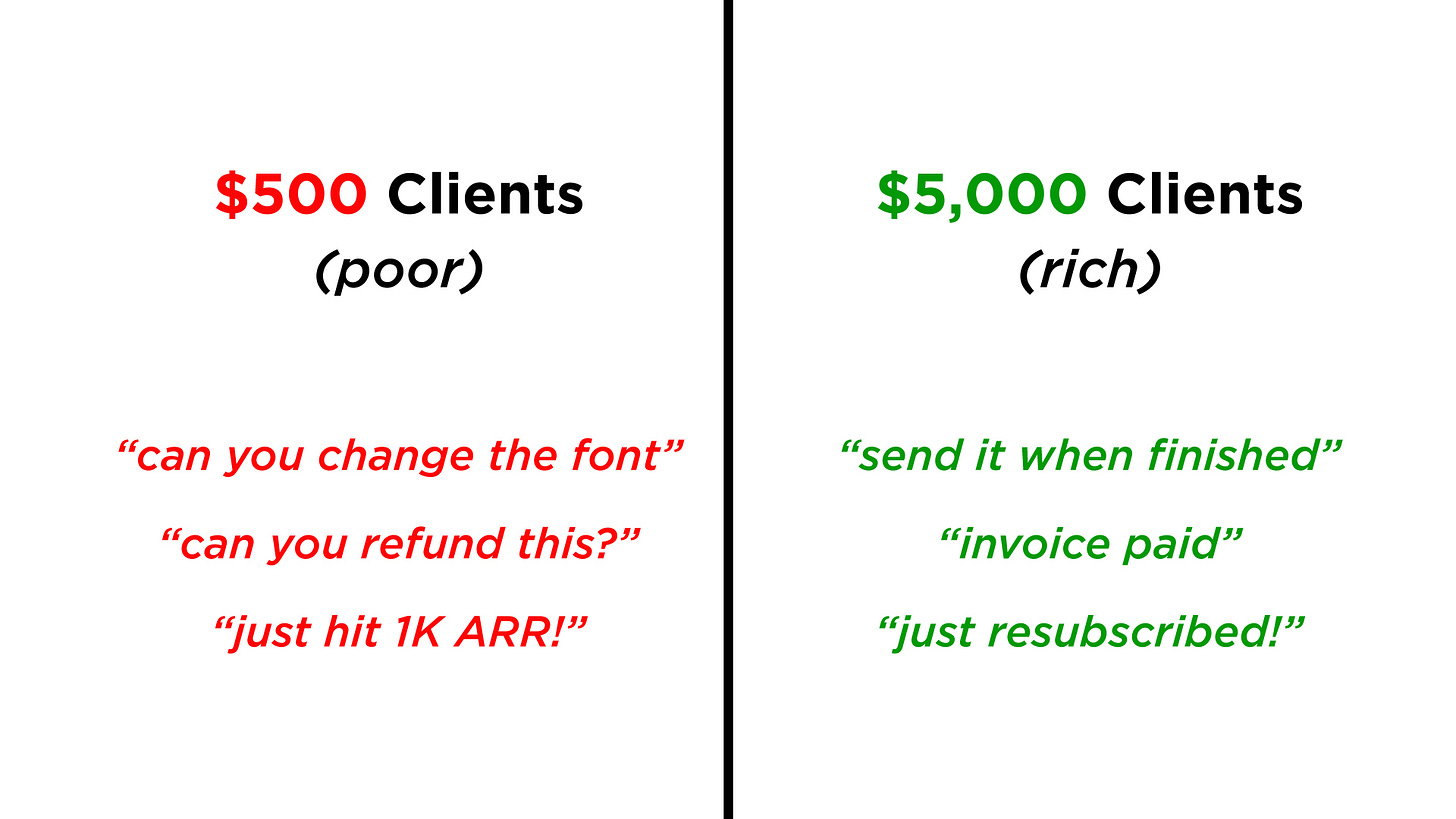$500 Clients VS $5000 Clients
For freelancers & agency owners: Increase your revenue by understanding what type of clients to work with.
I would have made 10 times more money if I had known this one small thing a few years back when I started in the service-based industry.
One of the reasons why I work, and many of you reading this work, is to make money.
I don't fool myself into thinking that I work for a greater cause or solely to solve customers' problems.
Don't lie to yourself and don't lie in general.
"It is really easy to fool people, and the easiest person to fool is yourself." - Naval Ravikant
You are working to make money first so you can pay your bills, live a certain lifestyle, and afford all the other things you want in life.
So, if you are working to make money, doesn’t it make sense that the amount of money you make should increase over time or that you should make more money any chance you get?
In this article, I will share strategies to help you increase your income if you are a freelancer or an agency owner.
The First Step to Making More Money in a Service-Based Business
The first step to increasing your earnings in a service-based business is to offer a high-ticket service. While I will discuss this further in a future article, my focus here is to help you earn more by improving your current approach.
If you're making $100, I want to help you make $500. If you're making $500, my goal is to help you reach $1,000, and so on.
Before I dive into the strategies, I want to establish why you should listen to me.
I dislike people who give advice without having achieved success themselves. Here are some of my achievements:
I charge an average of $15,000 - $30,000 per customer.
I have 15 people working under me.
There are certainly people who are ahead of me, and you can choose to follow their advice. My goal is not to convince you to listen to me but to introduce a thinking framework that has worked for me and can work for you too.
Prerequisites
Before applying these insights, ensure you meet these conditions:
You are providing a service online.
You have paying customers.
If you haven't figured out these basics, I recommend reading my other article that can help you get started.
The Core Strategy: Charge More
It's simple: increase your pricing.
"But my customers already complain about my current rates! How can I charge more?"
Yes, you have to charge more—and continuously increase your pricing.
It's better to focus on fewer high-paying customers than to serve many low-paying ones. I will explain how to distinguish between them.
High-Paying vs. Low-Paying Customers
High-paying customers:
Know what they are doing.
Have figured out their business model.
Understand the value of quality service.
Low-paying customers:
Have no clear business strategy.
Are struggling to make their business work.
Constantly ask for revisions outside of scope.
One of our first clients paid us ~$2,000 for building a mobile app. At the time, we accepted it out of desperation. However, the client lacked a clear business model and was not fully committed to the project. To this day, they still request changes to work we did years ago.
While this particular client became a good friend, in general, you should have clear start and end dates for your services. Avoid doing work beyond the agreed scope without additional payment.
Red Flags for Low-Paying Clients
They lack a clear vision or goal.
Their business is not their main source of income.
They speak negatively about previous service providers.
They have no clear plan to pay for your services.
They expect you to define their ideas and business for them.
How to Charge More
Become the Best at What You Do
If you want to attract high-paying clients, you need to improve your skills and services.
High-paying clients can distinguish between an average service provider and an expert.
Work on delivering the highest quality work possible.
As Napoleon Hill said, "The person who does more than they are paid for will soon be paid more than they do."
In my case, my team and I focused on creating the best UI/UX, writing high-quality code, and building robust applications. Our skill improvement enabled us to move from charging $2,000 to $40,000 for the same type of service.
Whatever your service—logo design, website development, email marketing, video editing—focus on mastering it.
Gradually Increase Your Prices
After improving your skills, start charging more.
If your last client paid you $500, the next one should pay $1,000.
Your pricing is largely influenced by your mindset.
If you believe you are worth $500, your clients will perceive you that way.
You must believe you are worth $1,000—and back it up with skill, work ethic, and service quality.
Build a Strong Portfolio and Collect Testimonials
Clients hesitate to pay more because they lack proof of your value.
Continuously improve your portfolio and collect as many testimonials as possible.
When a potential client approaches you, let your case studies and testimonials speak for you.
I have closed $40,000 deals from Upwork alone in less then 2 months purely based on our portfolio and brand presence.
This takes time, but if you are committed, it will pay off in the long run.
Offer a High-Ticket Service
If you want to charge premium prices, you must offer a high-value service.
You can’t charge $10,000 for email lead generation unless you are a proven expert.
However, if you have experience in software development, charging $10,000 for a product is more feasible.
Position yourself as an expert to differentiate yourself from the competition.
Consider Whether Your Clients Can Afford Your Service
Your customers must have the financial capacity to pay higher fees. If they can't, you need to shift your focus to clients who can.
Key Takeaways
Continuously improve your skills and service quality.
Shift your mindset to believe in your worth.
Offer a high-ticket service or position yourself uniquely in the market.
By implementing these strategies, you can start charging more and increasing your revenue over time.




